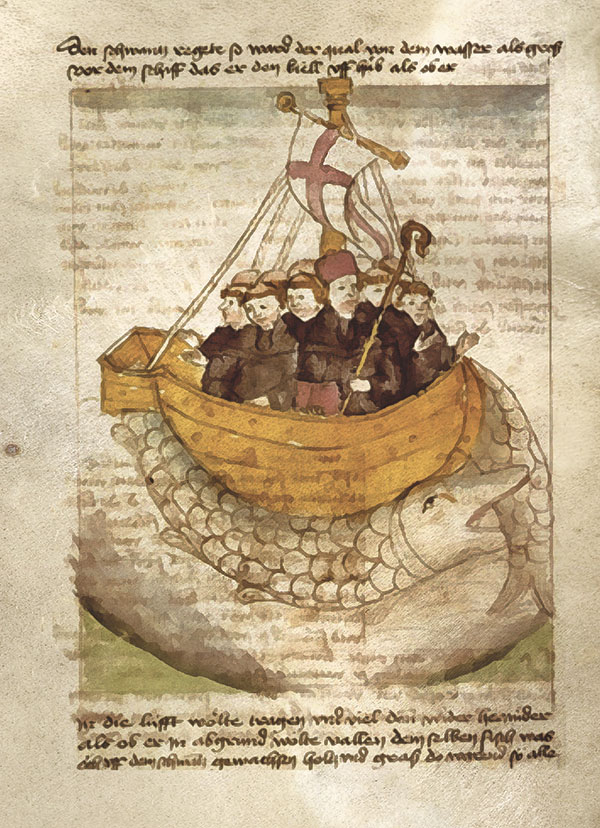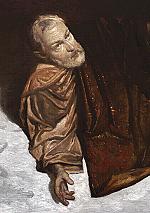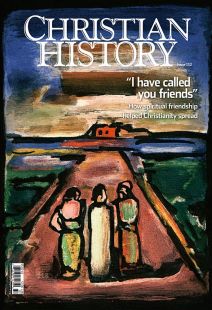The head of the body of Christ

[Voyage of St. Brendan the Navigator—Wikimedia]
ACCORDING TO THE NINTH-CENTURY Martyrology of Oengus, a young Irish priest frequently visited Brigid (d. 523), the abbess of a powerful monastery in Kildare. One day Brigid took the young cleric aside and asked if he had an anamchara (literally, “soul-friend”). When he replied in the affirmative, Brigid said, “We need to sing a requiem for your soul-friend, because he is dead.” Asked how she knew, Brigid replied, “When you were eating, I saw the food going directly into your torso, because you have no head. You need to go and find another soul-friend, because a person without a soul-friend is like a body without a head.”
This powerful abbess, ostensibly a friend of St. Patrick (and according to one controversial Vita an ordained bishop), knew that every believer—priests of the church included—needed a soul-friend.
So what exactly is an anamchara, a soul-friend?
No starry-eyed lovers
One of the challenges in historical research is that one cannot assume that words mean the same thing in different ages. When I say “I love you” to someone, I import a whole set of implications from my personal experience, my social group, and my culture; I cannot assume that a man in second-century Rome meant the same thing if he said “Te amo” to his companion.
We are faced with a similar problem with the Middle Irish word anamchara. It is tempting to romanticize the word into an endearment of starry-eyed lovers—“soulmate.” But that completely misses the implications of the term in Irish literature and culture. Using anamchara to identify one’s closest friend to whom the deepest secrets of one’s life may be revealed comes closer—but still misses the mark.
At the core of what makes an anamchara is spiritual concern. It is not a term of camaraderie; it is essentially penitential. The anamchara was for Irish Christians the spiritual mentor to whom believers revealed the darkest corners of their hearts—knowing that these beloved guides would support the disciples, confront their sin, and provide a remedy.
To ultimately trace down the word, we must begin not in the abbeys of medieval Ireland, but in the monastic cells of late ancient North Africa. A common theme among the desert fathers was how it benefited Christians to have a spiritual mentor who could encourage them in their walk with Christ. Evagrius Ponticus (345–399), a student of the teachings of the controversial Origen, spoke in the Praktikos (a guide to ascetic living) of the importance of elders who, because of spiritual insight, were able to prepare young ascetics for spiritual battle and heal the inevitable wounds of combat.
Some decades later monk and abbot John Cassian (c. 360–c. 435) recalled how Abbot Moses of Upper Egypt insisted that monks need elders to whom they should reveal their darkest secrets. The very act of confession to a spiritual guide, Moses believed, would lessen the power of sin’s grasp on younger disciples.
Cassian also established ascetic principles for his monastery in Marseilles. He was even more explicit than Evagrius about the importance of soul-friends. One of his Conferences (reminiscences of teaching sessions of the desert fathers) focused exclusively on spiritual friendship, an indissoluble bond in which two or more people are joined in a shared dwelling by the grace of God and for mutual spiritual benefit. In Institutes (c. 420), designed to provide a model for the monastic life, he spoke of the importance of young monks finding senior monks to whom they could share their deepest thoughts, holding back nothing.
From Egypt to Ireland
We know that Cassian’s writings in particular were mainstays of Irish monastic libraries by the Merovingian period (mid-fifth century). At the end of a long working day, a reader would recite the Institutes and the Conferences to the monks of the community as they ate their evening meals. It is not surprising, then, that the ethos of North African monasticism helped to mold Celtic spirituality and contribute to Christianizing an already-existing Celtic belief in mystical friendship transcending time, place, and position. Brigid, Colmcille (Columba), Máel Ruain, Fursa, even Patrick—each attested to the importance of the soul-friend in a Christian’s life, providing a listening ear, guidance in trouble, and companionship.
Perhaps the best example of the role the anamchara played is the Irish penitential—a manual for confessors to use in the reconciliation of repentant Christians. Building on Cassian’s perspective that the solution to sin lay in healing and restoration rather than punishment alone, penitentials contained detailed catalogs of sins categorized according to type of offense, social levels of offender and offended, and motive of the offender. They included appropriate penitential practices (usually fasting) for remediating the transgressions and restoring the transgressor to the community.
A confessor using the Irish penitential did not have to be a priest. He or she was often a trusted layperson to whom the penitent Christian could pour out every thought and deed. The aim was not immediate sacramental absolution but to be healed of the sin (ascetics had long believed that various foods caused lusts only overcome with fasting) and restored to the community.
Wandering friends
Early Celtic literature, both secular and sacred, is replete with stories of wandering Celts. From the pre-Christian genres of immrama and echtrai, in which Celtic heroes traveled from their homes to the otherworldly Tír na nÓg, to the Voyage of St. Brendan the Navigator, the Celts are portrayed as pilgrims always ready for a quest beyond the far horizon. When they became Christians, they did not stop traveling. Celtic Christianity was a missional religion.
Colmcille’s (521–597) mid-sixth-century founding of a monastery on the Scottish island of Iona represented the first missionary effort sent from Ireland. It also created the staging area for future missionary initiatives into Scotland, England, Wales, and the Continent. According to one tradition, Colmcille’s anamchara encouraged him to leave Ireland for Iona. He had been involved in a heated dispute between monasteries in which several people were killed. Some called for his excommunication, but his soul-friend, Brendan of Birr, suggested penitence: Colmcille would go into exile until he had converted as many people to Christ as had died in the conflict. According to his biographer, the saint continued to practice spiritual friendship while in exile.
Missionaries from Iona carried the tradition of soul-friends across the British Isles and beyond. When Aidan (d. 651) left Iona to lead a monastery on the English island of Lindisfarne off the Northumbrian coast, he carried a Christianity so steeped in Celtic tradition that he could not even preach in English well (which church historian Bede found charming), and he celebrated Easter according to the Irish calendar (Bede wholeheartedly disapproved).
But Bede noted the deep spiritual bond that grew between the godly King Oswald (c. 604–641) and Aidan—a relationship between a student and his mentor or, arguably, between a Christian believer and his anamchara. The soul-friend paradigm would also play out through the missionary efforts of St. Fursa, St. Columbanus, and others, and missionaries carried the penitentials used for spiritual counsel to the Continent.
In time, though, the penitentials would be banned in much of Christendom. The church’s commitment to the sacramental authority of ordained clergy to absolve sins superseded lay soul-friends dispensing remedies for sin. The anamchara of the penitentials, clearly intended to build up the Body of Christ in monastic settings, would ultimately be put out of business at the hands of the church in episcopal settings. They would seek for the head of the body in other ways. CH
By Garry J. Crites
[Christian History originally published this article in Christian History Issue #132 in 2019]
Garry J. Crites is the executive director of the National Alliance on Mental Illness in North Carolina.Next articles
“Our single object and ambition was virtue”
Spiritual friendship among the Cappadocians
Megan DeVoreSupport us
Christian History Institute (CHI) is a non-profit Pennsylvania corporation founded in 1982. Your donations support the continuation of this ministry
Donate






